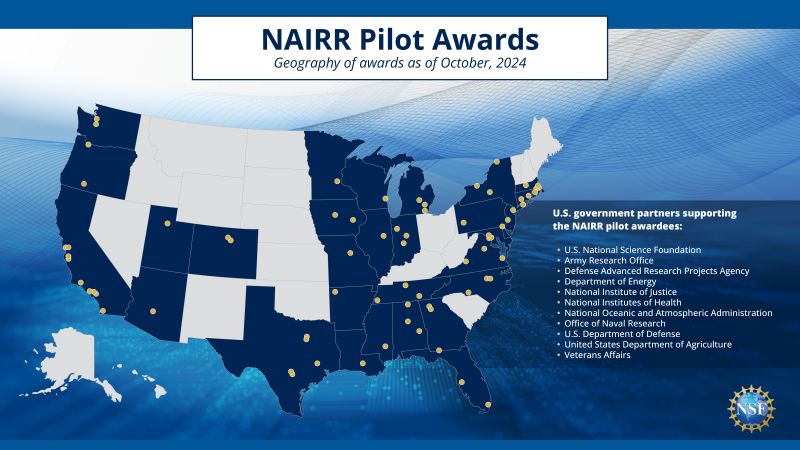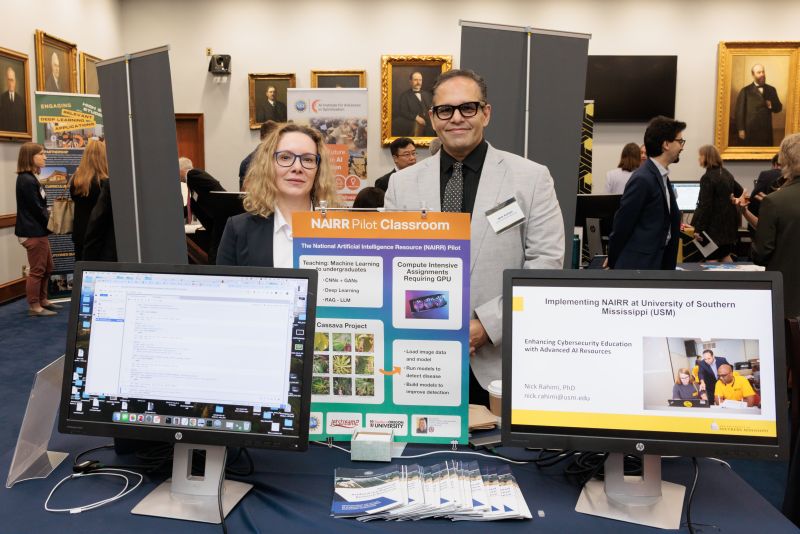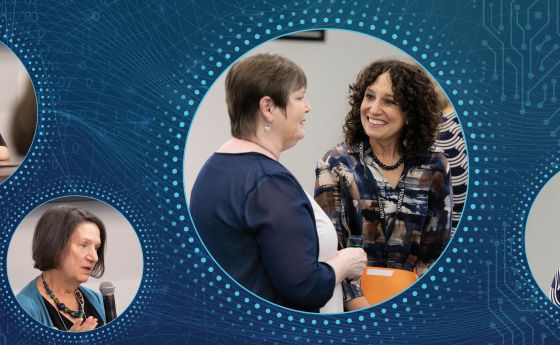
U.S. NAIRR pilot brings cutting-edge AI resources to researchers and educators across the nation
Artificial intelligence is rapidly moving from research labs into everyday life. Its impact can be seen in nearly every discipline, from health care to transportation, finance to education. Yet, to realize AI's full potential, we must pursue the talent and knowledge that exists in every corner of the nation to perform research, development and implementation.
The National Artificial Intelligence Research Resource (NAIRR) pilot—led by the U.S. National Science Foundation in partnership with 12 other federal agencies and more than 25 non-government contributors—is helping realize that vision.
Launched in January 2024 as the first step toward a future national AI research infrastructure, the NAIRR pilot partners have been working rapidly to connect a broad cohort of researchers and educators with essential AI research resources. The initiative is laying the foundation for an AI research ecosystem where ideas and innovations from a diverse pool of talent can thrive and benefit all Americans.
Establishing the NAIRR pilot
Only months after launch, the pilot's government, industry and nonprofit partners are contributing a wide array of unique, world-class AI systems, tools and services for use by researchers and educators. Those include NSF-supported advanced computing systems such as Delta, Frontera, Bridges-2, Expanse, Anvil,CloudBank, Neocortex and ACES system and classroom educational resources such as Jetstream-2 and the Prototype National Research Platform, as well as the U.S. Department of Energy-supported Summit system and Argonne National Laboratory AI testbeds.
Researchers are also matched to resources from non-governmental partners, including NVIDIA, Microsoft, Amazon, Google, SambaNova Systems, OpenAI, Anthropic, Hugging Face and Vocareum, and non-profit partners such as Ai2 are providing open resources.
However, the concept for the NAIRR originated with a letter to the research community highlighting the urgent need for a national AI research infrastructure that would ensure U.S. researchers and educators have access to the computational and data resources necessary to drive AI innovation.
To address that need, the National Artificial Intelligence Initiative Act of 2020 directed NSF and the White House Office of Science and Technology Policy with leading a task force of academic, industry, and government experts to create a blueprint for an AI capability that accelerates U.S. research and education about AI and using AI. The final report by the task force, published in January 2023, provided a roadmap for creating NAIRR, including the suggestion to start with a pilot project.
Artificial Intelligence is becoming a way of life, with new systems and uses popping up everyday. From AI chatbots to machine learning, this technology has the potential to shape our future ... positively or negatively. Dr. Michael Littman, with the U.S. National Science Foundation, talks about the early days of the field and how humanity has a role to play in developing the AI of the future.
Soon after, in October 2023, President Joe Biden issued the Executive Order on the Safe, Secure, and Trustworthy Development and Use of Artificial Intelligence, which directed NSF to launch a NAIRR pilot in collaboration with agency partners within 90 days. Since its launch with opportunities to apply for computing time, models, data, education tools, and other resources, the NAIRR pilot has generated tremendous demand from researchers and educators across the nation, including from underserved institutions and research communities that might otherwise have difficulty accessing such resources.
The pilot activities are helping lay a path for an eventual full-scale AI research infrastructure as envisioned in the NAIRR task force report. Through a competitive process, more than 150 resource awards have been made to support research and education in areas ranging from AI innovation and cybersecurity to agriculture, healthcare and wildfire detection. In addition to providing unique AI-related resources, the pilot is also fostering important community discussions on improving AI trustworthiness and reliability, and on how to lower barriers to access through common NAIRR software tools. NSF has also provided funding opportunities for NAIRR pilot demonstration projects, and NAIRR pilot expansion projects to test new ways of utilizing AI tools and systems for research and to encourage researchers and educators to participate in growing the NAIRR community.
"The need for AI infrastructure, research and education is only going to increase," said NSF Director Sethuraman Panchanathan. "In providing access to top-tier AI resources and expertise, the government, industry, and non-profit partners of the NAIRR pilot are helping our nation’s researchers and educators develop AI for the greater good and train our rapidly expanding AI workforce. NAIRR is meeting people where they are, regardless of geography or background, channeling the United States’ unique diversity into innovations and discoveries to advance a trustworthy global AI ecosystem and drive international standards, ensuring U.S. AI leadership for decades to come."
Delivering access to AI resources
In only a few months, the pilot has demonstrated the power of the NAIRR concept. Impacts generated by the initial awards supported by the pilot are already emerging.
For example, researchers at the University of Michigan are leveraging NVIDIA's DGX Cloud, Microsoft Azure, and OpenAI through the NAIRR pilot to accelerate the design and discovery of materials for energy storage. Their approach combines a molecular property prediction model with large language models (LLMs) to boost efforts for developing energy storage and conversion systems, which are essential for expanding the electrification of transportation. Those high-performance computing resources, often expensive and difficult for researchers to access, are made available in a uniquely convergent way by the pilot.
A NAIRR pilot project by researchers at the University of Illinois Urbana-Champaign is using the NSF-funded CloudBank resource to enable deaf and hard-of-hearing learners to access STEM videos. The cloud access will enable students to work collaboratively while they learn from the videos. Researchers with expertise in human-computer interaction, natural language processing and AI-augmented learning technologies are collaborating with Gallaudet University, the world's only liberal arts institution dedicated exclusively to the education of deaf and hard-of-hearing learners.
Doctoral students at the University of Utah are leveraging the DeltaAI system at the National Center for Supercomputing Applications to evaluate the accuracy, reliability, robustness and trustworthiness of compressed LLMs. Compressed LLMs use fewer resources and are less costly than many widely used versions, reducing barriers for smaller organizations and individual researchers. Researchers in this project are taking the first step towards evaluating compressed LLMs that may accelerate adoption of the approach by the research community.
Additionally, a NAIRR pilot award is expanding the work of David Baker of the University of Washington, co-recipient of the 2024 Nobel Prize in chemistry. Allocated 5,000 hours on the NSF-supported Lonestar system at the Texas Advanced Computing Center (TACC), Baker and his colleagues are training AI to help break through challenges in modeling biological interactions including between antibodies and other proteins.
Other research supported through the NAIRR pilot are tackling a wide range of challenges such as deepfake detection and AI safety, developing next-generation medical diagnoses, mapping permafrost disturbances, and identifying agricultural pests, among many others.
Broadening the AI workforce
Today's AI expertise is concentrated in certain regions and institutions around the country. Enabling an AI innovation ecosystem that addresses societal challenges affecting all communities will require a broad range of perspectives and technical directions. The NAIRR pilot aims to recruit and empower a wide range of researchers, educators and technologists, including those from underrepresented groups or underserved regions, two-year and four-year colleges, nonprofits and small businesses.
One step towards that goal is providing advanced AI education classroom tools to institutions that lack adequate access to them. For example, the University of Southern Mississippi is leveraging the Vocareum AI Notebook cloud platform through the NAIRR pilot to provide undergraduate students with cutting-edge resources for tackling real-world cybersecurity challenges using machine learning techniques.
Also through the NAIRR pilot, researchers at the UC Berkeley are using the Prototype National Research Platform at the San Diego Supercomputer Center at UC San Diego to assist environmental science and conservation graduate students in developing software that compares large models like ChatGPT with smaller, open, language models. The project’s goal is to show how generative AI can be part of a larger toolkit that provides accurate, trustworthy answers from reliable data sources.
At Southern Oregon University (SOU), which has few computing resources of its own, researchers are using the NAIRR pilot to access JetStream2, an NSF-supported cloud computing environment hosted at Indiana University, to introduce basic machine learning concepts to undergraduate students. The university's diverse student body includes a high percentage of first-generation college students, and this course aims to make machine learning accessible to those who may not have had previous exposure to advanced computational tools.
Enhancing infrastructure to support AI research
NSF is also investing heavily in the development of advanced computing to support the explosive demand for specialized AI resources. The Leadership-Class Computing Facility (LCCF) project led by TACC, is expected to begin operations during 2026 and will deploy Horizon, the largest NSF-supported academic supercomputer dedicated to open-scientific research. Horizon will include a significant investment in specialized accelerators, resulting in a 100x increase in AI computing capability over NSF's current largest system, Frontera.
NSF is also investing in expanding capabilities at its network of other supercomputers, data and software platforms, and through the NSF-led National Artificial Intelligence Research Institutes, NSF Regional Innovation Engines, and other institutions, platforms, systems and services to further accelerate AI research and innovation broadly, rapidly and responsibly.
The NAIRR pilot is demonstrating what could be unleashed across the nation by a fully implemented NAIRR, helping to define the effort and rapidly expand the partnerships needed to unlock the full potential of AI for U.S. researchers, educators and society, and ensure American leadership in the safe, secure, and trustworthy development of AI.
"In its full form, NAIRR will provide a future where AI computing and data resources are accessible to communities across the country, driving innovation and unleashing the ingenuity of the research community," said Katie Antypas, director of the NSF Office of Advanced Cyberinfrastructure. "It will enable our nation’s researchers to tackle key societal challenges, from extreme weather events to cancer treatments, food insecurity and poverty. The full NAIRR will catalyze economic growth and responsible AI development, and plant the seeds of discovery for decades to come."






